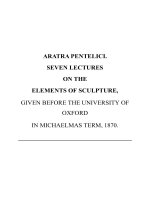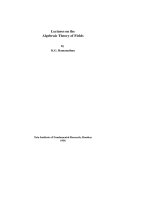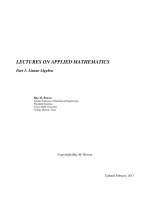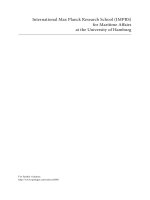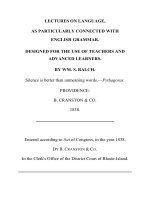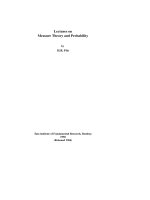Lectures on lexicology1
Bạn đang xem bản rút gọn của tài liệu. Xem và tải ngay bản đầy đủ của tài liệu tại đây (718 KB, 95 trang )
МИНИСТЕРСТВО ОБРАЗОВАНИЯ И НАУКИ РОССИЙСКОЙ ФЕДЕРАЦИИ
ГОУ ВПО «Татарский государственный гуманитарно-педагогический университет»
LECTURES ON ENGLISH
LEXICOLOGY
Курс лекций по лексикологии
английского языка
Казань 2010
МИНИСТЕРСТВО ОБРАЗОВАНИЯ И НАУКИ РОССИЙСКОЙ ФЕДЕРАЦИИ
ГОУ ВПО «Татарский государственный гуманитарно-педагогический университет»
LECTURES ON ENGLISH
LEXICOLOGY
Курс лекций по лексикологии
английского языка
для студентов факультетов иностранных языков
Казань 2010
ББК
УДК
Л
Печатается по решению Методического совета факультета иностранных
языков
Татарского
государственного
гуманитарно-педагогического
университета в качестве учебного пособия
Л
Lectures on English Lexicology. Курс лекций по лексикологии
английского языка. Учебное пособие для студентов иностранных языков. –
Казань: ТГГПУ, 2010 - 92 с.
Составитель:
к.филол.н., доцент Давлетбаева Д.Н.
Научный редактор:
д.филол.н., профессор Садыкова А.Г.
Рецензенты:
д.филол.н., профессор Арсентьева Е.Ф.
(КГУ)
к.филол.н., доцент Мухаметдинова Р.Г.
(ТГГПУ)
© Давлетбаева Д.Н.
© Татарский государственный гуманитарно-педагогический университет
INTRODUCTION
The book is intended for English language students at Pedagogical Universities
taking the course of English lexicology and fully meets the requirements of the
programme in the subject. It may also be of interest to all readers, whose command of
English is sufficient to enable them to read texts of average difficulty and who would
like to gain some information about the vocabulary resources of Modern English (for
example, about synonyms and antonyms), about the stylistic peculiarities of English
vocabulary, about the complex nature of the word's meaning and the modern methods
of its investigation, about English idioms, about those changes that English
vocabulary underwent in its historical development and about some other aspects of
English lexicology. One can hardly acquire a perfect command of English without
having knowledge of all these things, for a perfect command of a language implies
the conscious approach to the language's resources and at least a partial
understanding of the "inner mechanism" which makes the huge language system
work.
In this book the reader will find the fundamentals of the word theory and of the
main problems associated with English vocabulary, its characteristics and
subdivisions.
The aim of the course is to teach students to be word-conscious, to be able to
guess the meaning of words they come across from the meanings of morphemes, to
be able to recognise the origin of this or that lexical unit.
Lecture I. Working Definitions of Principal Concepts.
Lexicology is a branch of linguistics, the science of language. The term
Lexi c o l o g y is composed of two Greek morphemes: lexis meaning ‘word, phrase’
and logos which denotes ‘learning, a department of knowledge’. Thus, the literal
meaning of the term L e x i с o l о g у is ‘the science of the word’. The literal
meaning, however, gives only a general notion of the aims and the subject-matter of
this branch of linguistic science, since all its other branches also take account of
words in one way or another approaching them from different angles. Phonetics, for
instance, investigating the phonetic structure of language, i.e. its system of
phonemes and intonation patterns, is concerned with the study of the outer sound
form of the word. Grammar, which is inseparably bound up with Lexicology, is the
study of the grammatical structure of language. It is concerned with the various
means of expressing grammatical relations between words and with the patterns
after which words are combined into word-groups and sentences.
Lexicology as a branch of linguistics has its own aims and methods of
scientific research, its basic task being a study and systematic description of
vocabulary in respect to its origin, development and current use. Lexicology is
concerned with words, variable word-groups, phraseological units, and with
morphemes which make up words.
There are two principal approaches in linguistic science to the study of
language material, namely the synchronic (Gr. syn — ‘together, with’ and chronos
— ‘time’) and the diachronic (Gr. dia — ‘through’) approach. With regard to
S p e c i a l Lexicology the synchronic approach is concerned with the vocabulary of
a language as it exists at a given time, for instance, at the present time. It is special
D e s с r i p t i v e L e x i c o l o g y that deals with the vocabulary and vocabulary
units of a particular language at a certain time. A Course in Modern English
Lexicology is therefore a course in Special Descriptive Lexicology, its object of
study being the English vocabulary as it exists at the present time.
The diachronic approach in terms of Special Lexicology deals with the changes
and the development of vocabulary in the course of time. It is special Historical
Lexicology that deals with the evolution of the vocabulary units of a language as
time goes by. An English Historical Lexicology would be concerned, therefore, with
the origin of English vocabulary units, their change and development, the linguistic
and extralinguistic factors modifying their structure, meaning and usage within the
history of the English language.
Lexicology studies various lexical units: morphemes, words, variable wordgroups and phraseological units. We proceed from the assumption that the word is the
basic unit of language system, the largest on the morphologic and the smallest on the
syntactic plane of linguistic analysis. The word is a structural and semantic entity
within the language system.
Etymologically the vocabulary of the English language is far from being
homogeneous. It consists of two layers - the native stock of words and the borrowed
stock of words. Numerically the borrowed stock of words is considerably larger than
the native stock of words. In fact native words comprise only 30 % of the total
number of words in the English vocabulary but the native words form the bulk of the
most frequent words actually used in speech and writing. Besides the native words
have a wider range of lexical and grammatical valency, they are highly polysemantic
and productive in forming word clusters and set expressions.
Borrowed words (or loan words or borrowings) are words taken over from
another language and modified according to the patterns of the receiving language.
In many cases a borrowed word especially one borrowed long ago is practically
indistinguishable from a native word without a thorough etymological analysis (street,
school, face). The number of borrowings in the vocabulary of a language and the role
played by them is determined by the historical development of the nation speaking the
language. The most effective way of borrowing is direct borrowing from another
language as the result of contacts with the people of another country or with their
literature. But a word may also be borrowed indirectly not from the source language
but through another language. When analysing borrowed words one must distinguish
between the two terms - "source of borrowing" and "origin of borrowing". The first
term is applied to the language from which the word was immediately borrowed, the
second - to the language to which the word may be ultimately traced e.g. table source of borrowing - French, origin of borrowing - Latin elephant - source of
borrowing - French, origin-Egypt convene - source of borrowing - French, originLatin. The closer the two interacting languages are in structure the easier it is for
words of one language to penetrate into the other.
There are different ways of classifying the borrowed stock of words. First of all
the borrowed stock of words may be classified according to the nature of the
borrowing itself as borrowings proper, translation loans and semantic loans.
Translation loans are words or expressions formed from the elements existing
in the English language according to the patterns of the source language (the moment
of truth - sp. el momento de la verdad).
A semantic loan is the borrowing of a meaning for a word already existing in
the English language e.g. the compound word shock brigade which existed in the
English language with the meaning "аварийная бригада" acquired a new meaning
"ударная бригада" which it borrowed from the Russian language.
Latin Loans are classified into the subgroups.
1.Early Latin Loans. Those are the words which came into English through the
language of Anglo-Saxon tribes. The tribes had been in contact with Roman
civilisation and had adopted several Latin words denoting objects belonging to that
civilisation long before the invasion of Angles, Saxons and Jutes into Britain (cup,
kitchen, mill, port, wine).
2.Later Latin Borrowings. To this group belong the words which penetrated the
English vocabulary in the sixth and seventh centuries, when the people of England
were converted to Christianity (priest, bishop, nun, candle).
3.The third period of Latin includes words which came into English due to two
historical events: the Norman conquest in 1066 and the Renaissance or the Revival of
Learning. Some words came into English through French but some were taken
directly from Latin (major, minor, intelligent, permanent).
4.The Latest Stratum of Latin Words. The words of this period are mainly abstract
and scientific words (nylon, molecular, vaccine, phenomenon, vacuum).
Norman-French Borrowings may be subdivided into subgroups:
1.Early loans - 12th - 15th century
2.Later loans - beginning from the 16th century.
The Early French borrowings are simple short words, naturalised in accordance with
the English language system (state, power, war, pen, river) Later French borrowings
can be identified by their peculiarities of form and pronunciation (regime, police,
ballet, scene, bourgeois).
The Etymological Structure of the English Vocabulary:
The Native element:
I. Indo-European element
II. Germanic element
III. English proper element (brought by Angles, Saxons and Jutes not earlier than 5 th c.
A.D.)
The Borrowed Element:
I.
Celtic (5-6th c. A.D.)
II.
Latin: 1st group: B.C.
2nd group: 7 th c. A.D.
3d group: the Renaissance period
III.
Scandinavian (8-11 th c. A.D.)
IV.
French: 1. Norman borrowings (11-13th c. A.D.); 2. Parisian borrowings
(Renaissance)
V.
Greek
VI.
Italian (Renaissance and later)
VII.
Spanish (Renaissance)
VIII. German
IX.
Indian and others
Russian - English lexical correlations
Lexical correlations are defined as lexical units from different languages which
are phonetically and semantically related. Semantically Russian- English lexical
correlations are various. They may denote everyday objects and commonly used
things; brutal -грубый, cold - холодный, ground - грунт, kettle -котел, kitchen кухня, money - монета, sister - сeстра, wolf- волк etc.
For instance the word bolshevik was at first indivisible in English, which is seen
from the forms bolshevikism, bolshevikise, bolshevikian entered by some dictionaries.
Later on the word came to be divided into the morphological elements bolshev-ik.
The new morphological division can be accounted for by the existence of a number
of words containing these elements (bolshevism, bolshevist, bolshevise; sputnik,
udarnik, menshevik).
Assimilation is the process of changing the adopted word. The process of
assimilation of borrowings includes changes in sound form of morphological
structure, grammar characteristics, meaning and usage.
Phonetic assimilation comprises changes in sound form and stress. Sounds that
were alien to the English language were fitted into its scheme of sounds, e.g. In the
recent French borrowings communique, cafe the long [e] and [e] are rendered with the
help of [ei]. The accent is usually transferred to the first syllable in the words from
foreign sources.
The degree of phonetic adaptation depends on the period of borrowing: the earlier
the period the more completed this adaptation. While such words as "table", "plate"
borrowed from French in the 8th - 11th centuries can be considered fully assimilated,
later Parisian borrowings (15th c.) such as regime, valise, cafe" are still pronounced in
a French manner.
Grammatical adaption is usually a less lasting process, because in order to function
adequately in the recipient language a borrowing must completely change its
paradigm. Though there are some well-known exceptions as plural forms of the
English Renaissance borrowings - datum pl. data, criterion - pl. criteria and others.
The process of semantic assimilation has many forms: narrowing of meanings
(usually polysemantic words are borrowed in one of the meanings); specialisation or
generalisation of meanings, acquiring new meanings in the recipient language,
shifting a primary meaning to the position of a secondary meaning.
Completely assimilated borrowings are the words, which have undergone all types
of assimilation. Such words are frequently used and are stylistically neutral, they may
occur as dominant words in a synonymic group. They take an active part in wordformation.
Partially assimilated borrowings are the words which lack one of the types of
assimilation. They are subdivided into the groups:
1) Borrowings not assimilated semantically (e.g. shah, rajah). Such words usually
denote objects and notions peculiar to the country from which they came.
2) Loan words not assimilated grammatically, e.g. nouns borrowed from Latin or
Greek which keep their original plural forms (datum - data, phenomenon phenomena).
3)Loan words not completely assimilated phonetically. These words contain
peculiarities in stress, combinations of sounds that are not standard for English
(machine, camouflage, tobacco).
4) Loan words not completely assimilated graphically (e.g. ballet, cafe, cliche).
Barbarisms are words from other languages used by the English people in
conversation or in writing but not assimilated in any way, and for which there are
corresponding English equivalents e.g. ciao Italian - good-bye English,
The borrowed stock of the English vocabulary contains not only words but a great
number of suffixes and prefixes. When these first appeared in the English language
they were parts of words and only later began a life of their own as word-building
elements of the English language (-age, -ance, -ess, -merit) This brought about the
creation of hybrid words like shortage, hindrance, lovable and many others in which
a borrowed suffix is joined to a native root. A reverse process is also possible.
In many cases one and the same word was borrowed twice either from the same
language or from different languages. This accounts for the existence of the so called
etymological doublets like canal - channel (Latin -French), skirt - shirt (Sc. English), balsam - halm (Greek - French).
International words. There exist many words that were borrowed by several
languages. Such words are mostly of Latin and Greek origin and convey notions
which are significant in the field of communication in different countries. Here belong
names of sciences (philosophy, physics, chemistry, linguistics), terms of art (music,
theatre, drama, artist, comedy), political terms (politics, policy, progress). The
English language became a source for international sports terms (football, hockey,
cricket, rugby, tennis).
Lecture II. Working Definitions of Principal Concepts
The word is not the smallest unit of the language. It consists of morphemes.
The morpheme may be defined as the smallest meaningful unit which has a sound
form and meaning and which occurs in speech only as a part of a word.
Word formation is the creation of new words from elements already existing in
the language. Every language has its own structural patterns of word formation.
Morphemes are subdivided into root - morphemes and affixational morphemes.
The root morpheme is the lexical center of the word. It is the semantic nucleus
of a word with which no grammatical properties of the word are connected.
Affixational morphemes include inflections and derivational affixes.
Inflection is an affixal morpheme which carries only grammatical meaning thus
relevant only for the formation of word-forms (books, opened, strong-er).
Derivational morpheme is an affixal morpheme which modifies the lexical
meaning of the root and forms a new word. In many cases it adds the part-of-speech
meaning to the root (manage-ment, en-courage, fruit-ful)
Morphemes which may occur in isolation and function as independent words
are called free morphemes (pay, sum, form). Morphemes which are not found in
isolation are called bound morphemes (-er, un-, -less)
Morphemic analysis.
The segmentation of words is generally carried out according to the method of
Immediate and Ultimate Constituents. This method is based upon the binary principle,
i.e. each stage of procedure involves two components the word immediately breaks
into. At each stage these two components are referred to as the Immediate
Constituents (IC). Each IC at the next stage of analysis is in turn broken into smaller
meaningful elements. The analysis is completed when we arrive at constituents
incapable of further division, i.e. morphemes. These are referred to as Ultimate
Constituents (UC). The analysis of word-structure on the morphemic level must
naturally proceed to the stage of UC-s.
Allomorphes are the phonemic variants of the given morpheme e.g. il-, im-, ir-,
are the allomorphes of the prefix in- (illiterate, important, irregular, inconstant).
Monomorphic are root-words consisting of only one root-morpheme i.e. simple
words (dry, grow, boss, sell).
Polymorphic are words consisting of at least one root-morpheme and a number
of derivational affixes, i.e. derivatives, compounds (customer, payee, body-building,
shipping).
Derived words are those composed of one root-morpheme and one more
derivational morphemes (consignment, outgoing, publicity).
Derived words are those composed of one root-morpheme or more. Compound
words contain at least two root-morphemes (warehouse, camera-man),
Productivity is the ability to form new words after existing patterns which are
readily understood by the speakers of a language. Synchronically the most important
and the most productive ways of word-formation are affixation, conversion, wordcomposition and abbreviation (contraction). In the course of time the productivity of
this or that way of word-formation may change. Sound interchange or gradation
(blood - to bleed, to abide -abode, to strike - stroke) was a productive way of word
building in old English and is important for a diachronic study of the English
language. It has lost its productivity in Modern English and no new word can be
coined by means of sound gradation. Affixation on the contrary was productive in Old
English and is still one of the most productive ways of word building in Modern
English.
Affixation is the formation of new words with the help of derivational affixes.
Suffixation is more productive than prefixation. In Modern English suffixation is a
characteristic of noun and adjective formation, while prefixation is typical of verb
formation (incoming, trainee, principal, promotion).
Affixes are usually divided into living and dead affixes. Living affixes are
easily separated from the stem (care-ful). Dead affixes have become fully merged
with the stem and can be singled out by a diachronic analysis of the development of
the word (admit - L.- ad + mittere). Living affixes are in their turn divided into
productive and non-productive affixes. In many cases the choice of the affixes is a
mean of differentiating of meaning: uninterested - disinterested distrust – mistrust.
Word-composition is another type of word-building which is highly productive.
That is when new words are produced by combining two or more stems.
Stem is that part of a word which remains unchanged throughout its paradigm
and to which grammatical inflexions and affixes are added. The bulk of compound
words is motivated and the semantic relations between the two components are
transparent.
Compound words proper are formed by joining together stems of words already
available in the language. Compound proper is a word, the two Immediate
Constituents of which are stems of notional words, e.g. ice-cold (N + A), illluck(A+N).
Derivational compound is a word formed by a simultaneous process of
composition and derivation. Derivational compound is formed by composing a new
stem that does not exist outside this pattern and to which suffix is added. Derivational
compound is a word consisting of two Immediate Constituents, only one of which is a
compound stem of notional words, while the other is a derivational affix, e.g. blue eyed - (A+N) + ed In coordinative compounds neither of the components dominates
the other, both are structurally and semantically independent and constitute two
structural and semantic centres, e.g. breath-taking, self-discipline, word-formation.
Lecture III. Working Definitions of Principal Concepts
Conversion is a highly productive way of coining new words in Modern
English. Conversion is sometimes referred to as an affixless way of word-building, a
process of making a new word from some existing root word by changing the
category of a part of speech without changing the morphemic shape of the original
root-word. The transposition of a word from one part of speech into another brings
about changes of the paradigm.
Conversion is not only highly productive but also a particularly English way of
word-building. It is explained by the analytical structure of Modern English and by
the simplicity of paradigms of English parts of speech. A great number of onesyllable words is another factor that facilitates conversion.
Typical semantic relations within a converted pair
I. Verbs converted from noun (denominal verbs) denote:
1.action characteristic of the object ape (n) - to ape (v)
butcher (n) - to butcher (v)
2.instrumental use of the object screw (n) - to screw (v) whip (n) - to whip (v)
3.acquisition or addition of the object fish (n) - to fish (v)
II. Nouns converted from verbs (deverbal nouns) denote:
1. instance of the action:to jump (v) -jump (n); to move (v) - move (n)
2. agent of the action: to help (v) - help (n), to switch (v) - switch (n)
3. place of action: to drive (v) - drive (n), to walk (v) - walk (n)
4.object or result of the action: to peel (v) - peel (n), to find (v) - find (n).
The shortening of words involves the shortening of both words and wordgroups. Distinction should be made between shortening of a word in written speech
(graphical abbreviation) and in the sphere of oral intercourse (lexical abbreviation).
Lexical abbreviations may be used both in written and in oral speech. Lexical
abbreviation is the process of forming a word out of the initial elements (letters,
morphemes) of a word combination by a simultaneous operation of shortening and
compounding.
Clipping consists in cutting off two or more syllables of a word. Words that
have been shortened at the end are called apocope (doc-doctor, mit-mitten, vetveterinary). Words that have been shortened at the beginning are called aphaeresis
(phone-telephone). Words in which some syllables or sounds have been omitted from
the middle are called syncope (ma'm - madam, specs - spectacles). Sometimes a
combination of these types is observed (tec-detective, frig-refrigerator).
Blendings (blends, fusions or portmanteau words) may be defined as formation
that combine two words that include the letters or sounds they have in common as a
connecting element (slimnastics < slim+gymnasttcs; mimsy < miserable+flimsy;
galumph < gallop+triumph; neutopia < new+utopia). The process of formation is also
called telescoping. The analysis into immediate constituents is helpful in so far as it
permits the definition of a blend as a word with the first constituent represented by a
stem whose final part may be missing, and the second constituent by a stem of which
the initial part is missing. The second constituent when used in a series of similar
blends may turn into a suffix. A new suffix -on; is, for instance, well under way in
such terms as nylon, rayon, silon, formed from the final element of cotton. This
process seems to be very active. In present-day English numerous new words have
been coined recently: Reaganomics, Irangate, blacksploitation, workaholic,
foodoholic, scanorama etc.
Back formation is a semi - productive type of word-building. It is mostly active
in compound verbs, and is combined with word-composition. The basis of this type of
word-building is compound words and word-combinations having verbal nouns,
gerunds, participles or other derivative nouns as their second component (rushdevelopment, finger-printing, well-wisher). These compounds and word-combinations
are wrongly considered to be formed from compound verbs which are nonexistent in
reality. This gives a rise to such verbs as: to rush-develop, to finger-print, to wellwish.
Onomatopoeia (sound-imitation, echoism) is the naming of an action or thing
by a more or less exact reproduction of a natural sound associated with it (babble,
crow, twitter). Semantically, according to the source of sound onomatopoeic words
fall into a few very definite groups. Many verbs denote sounds produced by human
beings in the process of communication or in expressing their feelings (babble,
chatter, giggle, grumble, murmur, mutter, titter, whisper). There are sounds produced
by animals, birds and insects (buzz, cackle, croak, crow, hiss, howl, moo, mew, roar).
Besides the verbs imitating the sound of water (bubble, splash), there are others
imitating the noise of metallic things (clink, tinkle) or forceful motion (clash, crash,
whack, whip, whisk).
Sentence - condensation is the formation of new words by substantivising the
whole locutions (forget-me-not, merry-go-round).
Sound and stress interchange (distinctive stress, the shift of stress). The essence
of it is that to form a new word the stress of the word is shifted to a new syllable. It
mostly occurs in nouns and verbs. Some phonetic changes may accompany the shift
of the stress (export - to export, increase - to increase, break - breach, long -length).
Lecture IV. Working Definitions of Principal Concepts
Semasiology is a branch of linguistics concerned with the meaning of words
and word equivalents. The main objects of semasiological study are as follows: types
of lexical meaning, polysemy and semantic structure of words, semantic development
of words, the main tendencies of the change of word-meanings, semantic grouping in
the vocabulary system, i.e. synonyms, antonyms, semantic fields, thematic groups,
etc.
Referential approach to meaning. The common feature of any referential
approach is that meaning is in some form or other connected with the referent (object
of reality denoted by the word). The meaning is formulated by establishing the
interdependence between words and objects of reality they denote. So, meaning is
often understood as an object or phenomenon in the outside world that is referred to
by a word.
Functional approach to meaning. In most present-day methods of lexicological
analysis words are studied in context; a word is defined by its functioning within a
phrase or a sentence. This functional approach is attempted in contextual analysis,
semantic syntax and some other branches of linguistics. The meaning of linguistic
unit is studied only through its relation to other linguistic units. So meaning is viewed
as the function of a word in speech.
Meaning and concept (notion). When examining a word one can see that its
meaning though closely connected with the underlying concept is not identical with it.
To begin with, concept is a category of human cognition. Concept is the
thought of the object that singles out the most typical, the most essential features of
the object.
So all concepts are almost the same for the whole of humanity in one and the
same period of its historical development. The meanings of words, however, are
different in different languages. That is to say, words expressing identical concept
may have different semantic structures in different languages. E.g. the concept of "a
building for human habitation" is expressed in English by the word "house", in
Russian - "дом", but their meanings are not identical as house does not possess the
meaning of "fixed residence of family or household", which is part of the meaning of
the Russian word дом; it is expressed by another English word home.
The difference between meaning and concept can also be observed by
comparing synonymous words and word-groups expressing the same concept but
possessing linguistic meaning which is felt as different in each of the units, e.g. big,
large; to die to pass away, to join the majority, to kick the bucket; child, baby, babe,
infant.
Concepts are always emotionally neutral as they are a category of thought.
Language, however, expresses all possible aspects of human consciousness. Therefore
the meaning of many words not only conveys some reflection of objective reality but
also the speaker's attitude to what he is speaking about, his state of mind. Thus,
though the synonyms big, large, tremendous denote the same concept of size, the
emotive charge of the word tremendous is much heavier than that of the other word.
Meaning is a certain reflection in our mind of objects, phenomena or relations
that makes part of the linguistic sign - its so-called inner facet, whereas the soundform functions as its outer facet.
Grammatical meaning is defined as the expression in Speech of relationships
between words. The grammatical meaning is more abstract and more generalised than
the lexical meaning. It is recurrent in identical sets of individual forms of different
words as the meaning of plurality in the following words students, boob, windows,
compositions.
Lexical meaning. The definitions of lexical meaning given by various authors,
though different in detail, agree in the basic principle: they all point out that lexical
meaning is the realisation of concept or emotion by means of a definite language
system.
1)The component of meaning proper to the word as a linguistic unit, i.e. recurrent in
all the forms of this word and in all possible distributions of these forms. / Ginzburg
R.S., Rayevskaya N.N. and others.
2)The semantic invariant of the grammatical variation of a word / Nikitin M.V./.
3)The material meaning of a word, i.e. the meaning of the main material part of the
word which reflects the concept the given word expresses and the basic properties of
the thing (phenomenon, quality, state, etc.) the word denotes. /Mednikova E.M./.
Denotation. The conceptual content of a word is expressed in its denotative
meaning. To denote is to serve as a linguistic expression for a concept or as a name
for an individual object. It is the denotational meaning that makes communication
possible.
Connotation is the pragmatic communicative value the word receives
depending on where, when, how, by whom, for what purpose and in what contexts it
may be used. There are four main types of connotations stylistic, emotional,
evaluative and expressive or intensifying.
Stylistic connotations is what the word conveys about the speaker's attitude to
the social circumstances and the appropriate functional style (slay vs kill), evaluative
connotation may show his approval or disapproval of the object spoken of (clique vs
group), emotional connotation conveys the speaker's emotions (mummy vs mother),
the degree of intensity (adore vs love) is conveyed by expressive or intensifying
connotation.
The interdependence of connotations with denotative meaning is also different
for different types of connotations. Thus, for instance, emotional connotation comes
into being on the basis of denotative meaning but in the course of time may substitute
it by other types of connotation with general emphasis, evaluation and colloquial
stylistic overtone. E.g. terrific which originally meant 'frightening' is now a
colloquialism meaning 'very, very good' or 'very great': terrific beauty, terrific
pleasure.
The orientation toward the subject-matter, characteristic of the denotative
meaning, is substituted here by pragmatic orientation toward speaker and listener; it is
not so much what is spoken about as the attitude to it that matters.
Fulfilling the significative and the communicative functions of the word the
denotative meaning is present in every word and may be regarded as the central factor
in the functioning of language.
The expressive function of the language (the speaker's feelings) and the
pragmatic function (the effect of words upon listeners) are rendered in connotations.
Unlike the denotative meaning, connotations are optional.
Connotation differs from the implicational meaning of the word. Implicational
meaning is the implied information associated with the word, with what the speakers
know about the referent. A wolf is known to be greedy and cruel (implicational
meaning) but the denotative meaning of this word does not include these features. The
denotative or the intentional meaning of the word wolf is "a wild animal resembling a
dog that kills sheep and sometimes even attacks men". Its figurative meaning is
derived from implied information, from what we know about wolves - "a cruel greedy
person", also the adjective wolfish means "greedy".
Polysemy is very characteristic of the English vocabulary due to the
monosyllabic character of English words and the predominance of root words. The
greater the frequency of the word, the greater the number of meanings that constitute
its semantic structure. A special formula known as "Zipf's law" has been worked out
to express the correlation between frequency, word length and polysemy: the shorter
the word, the higher its frequency of use; the higher the frequency, the wider its
combinability , i.e. the more word combinations it enters; the wider its combinability,
the more meanings are realised in these contexts.
The word in one of its meanings is termed as lexico-semantic variant of this
word. For example the word table has at least 9 lexico-semantic variants: 1. a piece of
furniture; 2. the persons seated at a table; 3. sing. the food put on a table, meals; 4. a
thin flat piece of stone, metal, wood, etc.; 5. pl. slabs of stone; 6. words cut into them
or written on them (the ten tables); 7. an orderly arrangement of facts, figures, etc.; 8.
part of a machine-tool on which the work is put to be operated on; 9. a level area, a
plateau.
The problem in polysemy is that of interrelation of different lexico-semantic
variants. There may be no single semantic component common to all lexico-semantic
variants but every variant has something in common with at least one of the others.
All lexico-semantic variants of a word taken together form its semantic
structure or semantic paradigm. The word face, for example, according to the
dictionary data has the following semantic structure:
1.The front part of the head: He fell on his face,
2.Look, expression: a sad face, smiling faces, she is a good judge of faces.
3.Surface, facade: face of a clock, face of a building, He laid his cards face down.
4.fig. Impudence, boldness, courage; put a good/brave/ boldface on smth, put a new
face on smth, the face of it, have the face to do, save one's face.
5.Style of typecast for printing: bold-face type.
In polysemy we are faced with the problem of interrelation and
interdependence of various meanings in the semantic structure of one and the same
word.
No general or complete scheme of types of lexical meanings as elements of a
word's semantic structure has so far been accepted by linguists. There are various
points of view. The following terms may be found with different authors: direct /
figurative, other oppositions are: main / derived; primary / secondary; concrete/
abstract; central/ peripheral; general/ special; narrow / extended and so on.
Meaning is direct when it nominates the referent without the help of a context,
in isolation; meaning is figurative when the referent is named and at the same time
characterised through its similarity with other objects, e.g. tough meat - direct
meaning, tough politician - figurative meaning. Similar examples are: head - head of
a cabbage, foot -foot of a mountain, face - put a new face on smth. Differentiation
between the terms primary / secondary main / derived meanings is connected with
two approaches to polysemy: diachronic and synchronic.
If viewed diachronically polysemy, is understood as the growth and
development (or change) in the semantic structure of the word.
The meaning of the word table in Old English was the meaning "a flat slab of
stone or wood". It was its primary meaning, others were secondary and appeared later.
They had been derived from the primary meaning.
Synchronically polysemy is understood as the coexistence of various meanings
of the same word at a certain historical period of the development of the English
language. In that case the problem of interrelation and interdependence of individual
meanings making up the semantic structure of the word must be investigated from
different points of view, that of main/ derived, central /peripheric meanings.
An objective criterion of determining the main or central meaning is the
frequency of its occurrence in speech. Thus, the main meaning of the word table in
Modern English is "a piece of furniture".
Polysemy is a phenomenon of language, not of speech. But the question arises:
wouldn't it interfere with the communicative process ?
As a rule the contextual meaning represents only one of the possible lexicosemantic variants of the word. So polysemy does not interfere with the
communicative function of the language because the situation and the context cancel
all the unwanted meanings, as in the following sentences: The steak is tough- This is a
tough problem -Prof. Holborn is a tough examiner.
By the term "context" we understand the minimal stretch of speech determining
each individual meaning of the word. The context individualises the meanings, brings
them out. The two main types of linguistic contexts which serve to determine
individual meanings of words are the lexical context and the grammatical context.
These types are differentiated depending on whether the lexical or the grammatical
aspect is predominant in determining the meaning.
In lexical context of primary importance are lexical groups combined with the
polysemantic words under consideration.
The adjective heavy in isolation possesses the meaning "of great weight,
weighty". When combined with the lexical group of words denoting natural
phenomena as wind, storm, etc. it means "striking, following with force, abundant",
e.g. heavy rain, wind, storm, etc. In combination with the words industry, arms,
artillery and the like, heavy has the meaning "the larger kind of something as heavy
industry, artillery"
In grammatical context it is the grammatical (mainly the syntactic) structure of
the context that serves to determine various individual meanings of a polysemantic
word. Consider the following examples: 1) I made Peter study; He made her laugh;
They made him work (sing, dance, write...) 2) My friend made a good teacher 3) He
made a good husband.
In the pattern "to make + N(Pr)+ V inf' the word make has the meaning "to
force", and in the pattern "to make + A + N" it has the meaning "to turn out to be".
Here the grammatical context helps to determine the meaning of the word "to make".
So, linguistic (verbal) contexts comprise lexical and grammatical contexts.
They are opposed to extra linguistic contexts (non-verbal). In extra- linguistic
contexts the meaning of the word is determined not only by linguistic factors but also
by the actual situation in which the word is used.
Extension (widening of meaning). The extension of semantic capacity of a
word, i.e. the expansion of polysemy in the course of its historical development, e.g.
manuscript originally "smth hand-written".
Narrowing of meaning. The restriction of the semantic capacity of a word in the
historical development, e.g. meat in OE meant "food and drink".
Elevation (or amelioration). The semantic change in the word which rises it
from humble beginning to a position of greater importance, e.g. minister in earlier
times meant merely "a servant".
Degradation (or_degeri.eration). The semantic change, by which, for one
reason or another, a word falls into disrepute, or acquires some derogatory emotive
charge, e.g. silly originally meant "happy".
The change in the denotational component brings about the extension or the
restriction of meaning. The change in the connotational component may result in the
degradation - pejorative or ameliorative development of meaning.
Metaphor. The transfer of name based on the association of similarity. It is the
application of a name or a descriptive term to an object to which it is not literally
applicable, e.g. head of an army, eye of a needle.
Metonymy. The transfer of name based on the association of contiguity. It is a
universal device in which the name of one thing is changed for that of another, to
which it is related by association of ideas, as having close relationship to one another,
e.g. the chair may mean "the chairman", the bar -"the lawyers".



